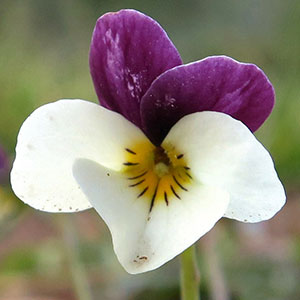Viola hallii
Viola quercetorum
Hall's violet, Oregon violet, wild pansy
goosefoot violet, goosefoot yellow violet, oakwoods violet
1–3, decumbent or ascending to erect, ca. 1/2 subterranean, glabrous, clustered on single, short, vertical, deep-seated caudex.
1–5, spreading to erect, leafy proximally and distally, usually elongated by end of season, puberulent to canescent, on caudex from subligneous rhizome.
basal and cauline;
basal: 1–4, palmately compound, ± 2-ternate or 3-ternate, leaflets 3;
stipules adnate to petiole, forming 2 linear-lanceolate wings, unlobed, margins entire, apex of each wing free, acute;
petiole 5–8 cm, glabrous;
blade ovate to deltate, 2.8–6 × 2.6–6.5 cm, ± coriaceous, base tapered, ultimate lobes narrowly elliptic, lanceolate, or oblanceolate, 1–7 mm wide, margins entire, ciliate or eciliate, apex acute, mucronulate, surfaces glabrous;
cauline similar to basal except: stipules usually lanceolate, sometimes broadly ovate, ± leaflike, margins toothed;
petiole 1.3–6 cm;
blade 2–4.8 × 1.2–5.5 cm.
basal and cauline;
basal: 1–6;
stipules adnate to petiole, forming 2 linear, membranous wings, each wing with lanceolate to ± deltate projection, margins entire or laciniate, apex usually long-acuminate or divided into narrow, filiform processes;
petiole 1.9–9.5 cm, puberulent;
blade usually grayish green to whitish, sometimes ± purple-tinted abaxially, green to grayish green adaxially, ± ovate to ± orbiculate, deltate, pandurate, or broadly brownish purple abaxially, lower 3 dark brown-veined, lateral 2 sparsely to densely bearded, lowest 10–16 mm, spur yellow to reddish brown, gibbous, 1–2 mm;
style head bearded; cleistogamous flowers axillary.
2.5–11 cm, glabrous.
sepals lanceolate to ovate, margins ciliate, auricles 0.5–1 mm;
petals: upper 2 almost black abaxially, dark reddish violet adaxially, lower 3 pale yellow, cream, or ± white, lateral 2 bearded, with deep yellow to orange patch basally, dark reddish violet-veined, lowest with deep yellow to orange patch basally, dark reddish violet-veined, 5–18 mm, spur yellow, gibbous, 0.5–2 mm;
style head bearded; cleistogamous flowers absent.
ellipsoid, 4–12 mm, glabrous.
ovoid to ellipsoid, 8–12 mm, puberulent.
light brown, shiny, 3.2–3.5 mm.
medium brown, ± 2.7 mm.
= 60, 72.
= 24.
Viola hallii
Viola quercetorum
Viola hallii was discovered on the grounds of Willamette University in Salem, Oregon, by Elihu Hall, a professor at that institution (V. B. Baird 1942). Leaves of V. hallii are similar to V. beckwithii.
(Discussion copyrighted by Flora of North America; reprinted with permission.)
Herbarium specimens of Viola quercetorum and V. purpurea var. purpurea can be difficult to distinguish; pressing obliterates the undulate leaf margins of V. quercetorum. In Oregon, most collections of V. quercetorum are from yellow pine forests (A. Liston, pers. comm.).
Viola quercetorum hybridizes with V. douglasii (J. Clausen 1964).
(Discussion copyrighted by Flora of North America; reprinted with permission.)


